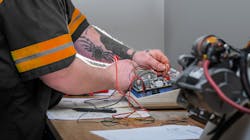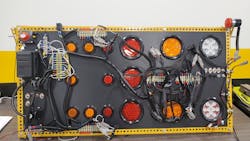Tactics for lighting and electrical diagnostics and repairs
Keeping the lights on for truckers is more than a financial euphemism, it's a maintenance necessity, especially when lighting was one of the top five out-of-service violations in 2022's Commercial Vehicle Safety Alliance International Roadcheck inspections. With 2,084 vehicles sidelined for lighting issues during 2022's inspection gamut, technicians know that making sure their fleets' lights are in top condition is no laughing matter, but that does not mean making electrical repairs has gotten any easier.
To the contrary, electric repairs can be finnicky at best, and require careful troubleshooting lest a technician miss the root cause of a problem that may cause more than one fault code. Luckily, lighting experts have some specific tips for electrical diagnostics and repairs beyond basic, common-sense troubleshooting, especially when specific problems present themselves.
Intermittent turn signal failure
With an oscilloscope, noted Michael Eilbracht, trainer, Diesel Laptops, you can look at multiple circuits at the same time, which gives you a better chance of finding faults faster.
“For example, let’s say a bus comes in with a complaint of left turn signals working intermittently,” Eilbracht offered. “In this case, the turn signals are multiplex controlled, meaning a module controls how long the turn signals are on and off. Using three low-amp probes with three wires in each, turn on the left turn signals and look at the currents coming from the clamps. The one channel that has the most current is the culprit.”
Voltage drop test procedures
In situations where the wiring is not contained in a sealed harness and you are able to access both the positive and ground circuits, you can use a multimeter to determine voltage drop, related Andrew Summers, director of fleet sales at Phillips Industries.
“First take the voltage on the positive side wiring from the power source to the component to read voltage drop,” Summers continued. “Check the allowable drop for the size and length of wiring you are testing and if the reading is outside this range, work your way back between connections until you find the section of wire where the issue is located.”
If no problems are found, Summer said to repeat the test on the ground side starting at the main ground for the component and working your way through the ground path. “Pay special attention to any frame grounds, as corrosion, paint under the connection, and loose connections can all create voltage drop,” he advised. “If voltage drop is minimal on both sides of the circuit, then the issue is likely the component.”
For voltage drop tests on a sealed harness system, Summers noted, use a multimeter to read the voltage at the power source for the component. On tractors, it will usually be at the batteries, the alternator, or power distribution panel. On trailers, unplug the 7-way cord at the trailer, and measure the voltage at the plug on the cable of the circuit you are testing (running lights, clearance, brake, etc.).
If the voltage is acceptable, then plug the cable back in.
NOTE: To determine how much voltage drop is acceptable in a cable, use an online calculator.
Diagnostic and repairs steps
“Sometimes there is more wrong than has been reported, and it can help narrow down where the fault is located,” said Phillip Pinter, sr. technician, FedEx Freight. “With most circuits having multiple lights attached, if more than one is having the issue, it allows for points of commonality to be looked at and get you closer to the problem.”
To verify complaints, Pinter recommended hooking up the trailer to a tractor or a trailer testing unit and inspecting all lights. “If no other issues are found, use a multimeter and check for power and ground at the light,” he said. “If either is missing, work your way back through the harness until the problem is found.
“If everything measures correctly with a meter, use a circuit loading device and verify the wiring can carry the load required," Pinter continued. “A partially damaged wire may give you correct readings when no load is on it but fail if trying to operate something. If the load test fails, move the ground to a known good spot and test again. If it still fails, the problem is in the power supply. If it passes, the issue is with the ground circuit.”
Finally, Pinter said to use an external power supply to put energy directly to the light and verify if it operates.
Quick fixes are only a short-term solution
When lights go out on the road, a quick roadside fix may require butt connectors or terminals, noted Larry Rambeaux, sales application engineer, Purkeys. “However, generic connectors are prone to water intrusion and corrosion, so they need to be replaced,” he said.
Rambeaux went on to provide an example of issues with roadside repairs involving liftgate charging systems:
A technician moves the wiring until they get a light and assumes it’s working, but that doesn’t mean the system is charging. In order to hurry the repair along, the technician may change the liftgate batteries, but if the charging system wasn’t repaired, the new batteries will drain and cause another issue.
Follow established guidelines
Follow TMC RPs for effective diagnostic and repair procedures, Rambeaux advised, including several that show proper wire repair procedures, how to select the right kind of wires, etc. RPs also apply to setting up lighting and electrical repair workstations.
“If TMC RP repair procedure guidelines are followed,” he added, “fleets can use them and established procedures to successfully repair electrical systems.”
About the Author

Seth Skydel
Seth Skydel, a veteran industry editor, has more than 36 years of experience in fleet management, trucking, and transportation and logistics publications. Today, in editorial and marketing roles, he writes about fleet, service, and transportation management, vehicle and information technology, and industry trends and issues.

